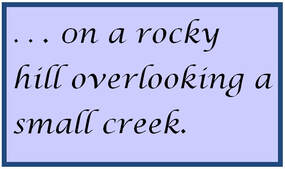A Child's Grave
By Glynda Pflug
The Panhandle area of Texas in the late 1870's was mostly populated with cattle grazed by some big ranches on land leased from the State of Texas. The land today is marked by trails worn in the land and by graves marking where people passed or lived.
The nearest cattle market was 200 miles north at Dodge City, Kansas. The cattle were driven to market in large cattle drives and soon their feet wore a trail in the grass all the way to Kansas. Travelers going by horse and buggy, wagons, stage coaches and horseback started using those trails to make their way across the country.
A day's travel was about 30 miles and there were placed to stop along the way. One of those stops was The Little Blue Stage Stop about 11 miles east of Dumas. The stage stop was operated by a family named "Moore." (No connection to the name of the county.)
The Moores cared for extra horses for the stage, cooked for travelers and provided overnight lodging. The family had a small boy.
The nearest cattle market was 200 miles north at Dodge City, Kansas. The cattle were driven to market in large cattle drives and soon their feet wore a trail in the grass all the way to Kansas. Travelers going by horse and buggy, wagons, stage coaches and horseback started using those trails to make their way across the country.
A day's travel was about 30 miles and there were placed to stop along the way. One of those stops was The Little Blue Stage Stop about 11 miles east of Dumas. The stage stop was operated by a family named "Moore." (No connection to the name of the county.)
The Moores cared for extra horses for the stage, cooked for travelers and provided overnight lodging. The family had a small boy.

One day, John Arnot, a LX cowboy, was riding the drift fence checking for LX Cattle and stopped at the stage shop. The little boy had wandered away from home that day and John joined the search for him, finally finding him in a water pond where he had died.
The Moores buried him there on the prairie on a rocky hill overlooking a small creek. They found a big flat rock and chiseled the name "Moore" on the rock. They stood it up by the grave and put pretty rocks around it.
The markings on the stone grow fainter as the years pass, but decades later it was still possible to read the last two letters. The grave is believed to have been made in 1890. At one time, a fence was built around the grave in attempt to preserve the site. Girl Scouts of Moore County have used the ranchland for their annual Day Camps and hike to the grave site each year. They take their gloves, hoes, shovels, and other tools and maintain the grave site as best they can.
The deep wagon ruts that were made by the stage line can still be seen by looking closely and some of the wire and posts of the famous "drift fence" might still be there. It is in the same area that legends tell about John Arnot killing the last buffalo in the Panhandle of Texas.
The Moore grave is one of the oldest in the county. Other early graves were John Leverton in 1886 in Evans Canyon, Charlie Bennett in 1905 in Palo Duro Cemetery and Charles Hamilton Record in 1900 in the Record Cemetery. In 1895, Jessie Bennett was buried in Dumas Cemetery and according to history records "Mr. and Mrs. Howe were the other two graves there then." Cemetery records do not show the location of the Howe graves.
The Moores buried him there on the prairie on a rocky hill overlooking a small creek. They found a big flat rock and chiseled the name "Moore" on the rock. They stood it up by the grave and put pretty rocks around it.
The markings on the stone grow fainter as the years pass, but decades later it was still possible to read the last two letters. The grave is believed to have been made in 1890. At one time, a fence was built around the grave in attempt to preserve the site. Girl Scouts of Moore County have used the ranchland for their annual Day Camps and hike to the grave site each year. They take their gloves, hoes, shovels, and other tools and maintain the grave site as best they can.
The deep wagon ruts that were made by the stage line can still be seen by looking closely and some of the wire and posts of the famous "drift fence" might still be there. It is in the same area that legends tell about John Arnot killing the last buffalo in the Panhandle of Texas.
The Moore grave is one of the oldest in the county. Other early graves were John Leverton in 1886 in Evans Canyon, Charlie Bennett in 1905 in Palo Duro Cemetery and Charles Hamilton Record in 1900 in the Record Cemetery. In 1895, Jessie Bennett was buried in Dumas Cemetery and according to history records "Mr. and Mrs. Howe were the other two graves there then." Cemetery records do not show the location of the Howe graves.